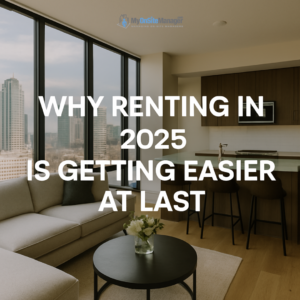Good news for renters: After years of sky-high prices, the U.S. rental market is finally showing signs of relief. According to a recent report from Redfin, the median asking rent across the U.S. has fallen to $1,653 as of June 2025, making it the most affordable it has been since the early days of the COVID-19 pandemic.
This marks a $60 decrease—or about 3.4%—from the market’s all-time peak in August 2022. It’s a subtle but meaningful shift, especially after a long stretch where renters were burdened with steep monthly increases.
What’s Behind the Drop in Rent?
Several factors have contributed to this turn toward affordability:
1. A Boom in Apartment Construction
Over the past few years, developers raced to meet soaring demand by building new apartment complexes. Many of those projects are now complete and entering the market, increasing supply at a time when rental demand is stabilizing.
-
The U.S. has seen one of its largest housing construction booms in decades.
-
As a result, vacancy rates are rising, giving renters more options and landlords less leverage to raise prices.
2. Slowing Renter Demand
The pandemic drove significant shifts in where and how people lived. Many urban renters moved to suburban or rural areas, while others doubled up with roommates or moved in with family to save money. Now, that frenzied demand has cooled.
-
Remote work continues to influence renter preferences, distributing demand more evenly across regions.
-
Economic uncertainty and inflation have also made some renters more cautious about taking on high monthly costs.
3. Household Budgets Are Under Pressure
With inflation affecting everything from groceries to gas, many renters are pushing back on price hikes or choosing more affordable housing. Landlords are responding with price reductions and move-in incentives to attract tenants.
Key Stats: U.S. Rental Trends at a Glance
| Date | Median Asking Rent | % Change from Peak |
|---|---|---|
| August 2022 (Peak) | $1,713 | — |
| June 2025 (Now) | $1,653 | -3.4% |
This is the third consecutive year that rent prices have declined nationally. It marks a positive shift for renters after years of unaffordable housing costs, particularly in major metro areas.
Where Is Rent Dropping the Fastest?
While the national trend is downward, the level of affordability varies widely by region:
-
Cities with the biggest rent decreases: Areas that saw an oversupply of luxury apartments—especially in Sunbelt metros like Austin, Phoenix, and Las Vegas—have had some of the biggest drops.
-
Still-hot markets: Popular coastal cities like New York and Los Angeles remain pricey, though growth has slowed.
-
Mid-size cities: Places like Kansas City, Cleveland, and Indianapolis are emerging as more affordable alternatives for renters priced out of big cities.
What This Means for Renters
Here’s how you can take advantage of the current market:
1. Negotiate Your Lease
With more supply on the market, you may have leverage to negotiate your rent, especially if you’re renewing in a complex with high vacancies.
2. Shop Around
If you’re considering moving, now might be the time. More units mean more options, and landlords are more likely to offer discounts, waived application fees, or even a free month of rent.
3. Look Beyond Big Cities
Renters willing to consider mid-sized or less densely populated areas may find even better deals without sacrificing lifestyle quality.
4. Budget Smart
Even though rents are falling, inflation is still high. Consider how any rent savings can be redirected toward savings, emergency funds, or paying off debt.
A Word of Caution
While rents are down on average, affordability remains a challenge for many. In some high-demand cities, prices are still well above pre-pandemic levels, and income growth hasn’t always kept up.
Additionally, many renters are still considered cost-burdened, spending more than 30% of their income on rent—especially in low-income households.
Final Thoughts
After years of rising prices and limited availability, renters are finally catching a break. The market is shifting—thanks to increased housing supply, stable demand, and economic pressures—which means more choices and better deals for tenants.
But while the news is encouraging, the affordability crisis isn’t over. Renters should stay informed, shop wisely, and use this moment to make financially sound housing decisions.
Source: Newsweek – Rent Is Most Affordable Since COVID Pandemic: Report

